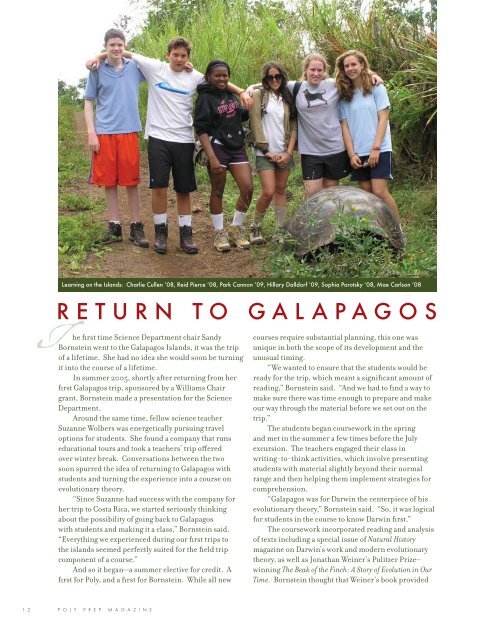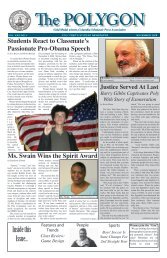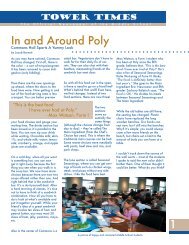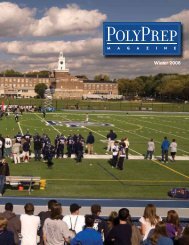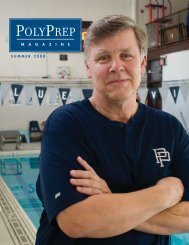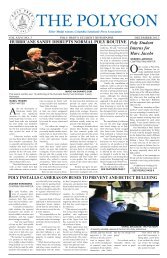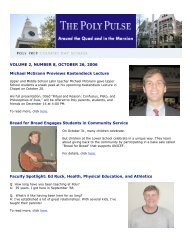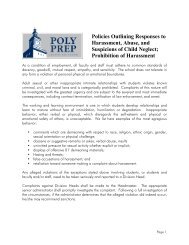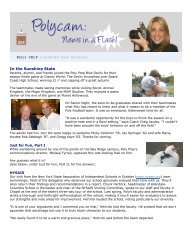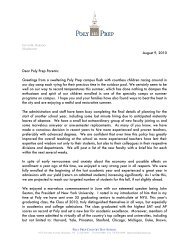Together . . . - Poly Prep Country Day School
Together . . . - Poly Prep Country Day School
Together . . . - Poly Prep Country Day School
You also want an ePaper? Increase the reach of your titles
YUMPU automatically turns print PDFs into web optimized ePapers that Google loves.
Learning on the Islands: Charlie Cullen ’08, Reid Pierce ’08, Park Cannon ’09, Hillary Dalldorf ’09, Sophia Porotsky ’08, Mae Carlson ’08<br />
T R E T U R N T O g a l a p a g o s<br />
he first time Science Department chair Sandy<br />
Bornstein went to the Galapagos Islands, it was the trip<br />
of a lifetime. She had no idea she would soon be turning<br />
it into the course of a lifetime.<br />
In summer 2005, shortly after returning from her<br />
first Galapagos trip, sponsored by a Williams Chair<br />
grant, Bornstein made a presentation for the Science<br />
Department.<br />
Around the same time, fellow science teacher<br />
Suzanne Wolbers was energetically pursuing travel<br />
options for students. She found a company that runs<br />
educational tours and took a teachers’ trip offered<br />
over winter break. Conversations between the two<br />
soon spurred the idea of returning to Galapagos with<br />
students and turning the experience into a course on<br />
evolutionary theory.<br />
“Since Suzanne had success with the company for<br />
her trip to Costa Rica, we started seriously thinking<br />
about the possibility of going back to Galapagos<br />
with students and making it a class,” Bornstein said.<br />
“Everything we experienced during our first trips to<br />
the islands seemed perfectly suited for the field trip<br />
component of a course.”<br />
And so it began—a summer elective for credit. A<br />
first for <strong>Poly</strong>, and a first for Bornstein. While all new<br />
courses require substantial planning, this one was<br />
unique in both the scope of its development and the<br />
unusual timing.<br />
“We wanted to ensure that the students would be<br />
ready for the trip, which meant a significant amount of<br />
reading,” Bornstein said. “And we had to find a way to<br />
make sure there was time enough to prepare and make<br />
our way through the material before we set out on the<br />
trip.”<br />
The students began coursework in the spring<br />
and met in the summer a few times before the July<br />
excursion. The teachers engaged their class in<br />
writing-to-think activities, which involve presenting<br />
students with material slightly beyond their normal<br />
range and then helping them implement strategies for<br />
comprehension.<br />
“Galapagos was for Darwin the centerpiece of his<br />
evolutionary theory,” Bornstein said. “So, it was logical<br />
for students in the course to know Darwin first.”<br />
The coursework incorporated reading and analysis<br />
of texts including a special issue of Natural History<br />
magazine on Darwin’s work and modern evolutionary<br />
theory, as well as Jonathan Weiner’s Pulitzer Prize–<br />
winning The Beak of the Finch: A Story of Evolution in Our<br />
Time. Bornstein thought that Weiner’s book provided<br />
1 2 P O L Y P R E P M A G A Z I N E


